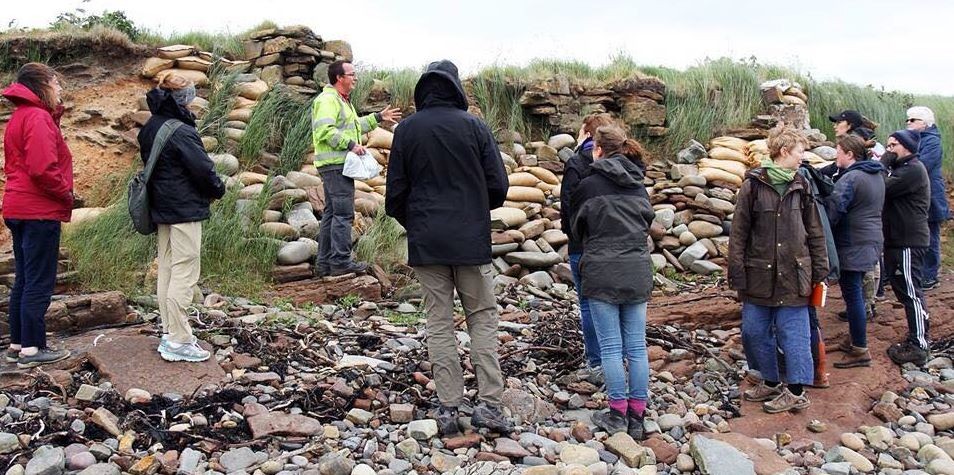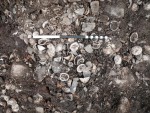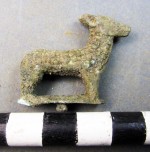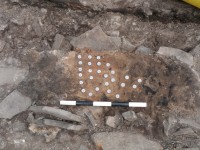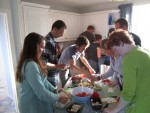The Newark Project
Back in June last year, the Newark chapel site had a visit from the Scottish Coastal Heritage At Risk Programme team to view our efforts thus far in attempting to buy time for the site. There were experts from St Andrews and Stirling Universities, the University of Florida, the US National Parks Department and Historic Environment Scotland and they all were greatly interested in the site's history.
It wasn't the warmest of days, so afterwards the whole group sped back to the hall for welcome coffee and shortbread.......and talking....a lot of talking and yet more talking, with Isobel Gardner, Ann Johnston, Anne Mitchell and Dave Reay flying the flag for Deerness.
Well - a couple of hundred sandbags later, there have been developments! First HES funded the purchase of 500 more sandbags and then encouraged ORCA, UHI Archaeology Institute based at Orkney College to put in an application for a grant to consolidate all that has gone before with regard to the site, all the findings and papers etc. and now - with the latest technology available - do further carbon dating, isotope analysis and DNA testing on a high percentage of the already excavated skeletons. A big thank you to HES - ORCA got the substantial award for a 3 year project, heavily involving the local community and culminating in major exhibitions at the Orkney Museum, and back here in Deerness at probably the hall and St Ninian's.
Two years ago, the discovery of the Pictish sculptured cross slab concentrated academic minds on Newark, and with the folk buried in the medieval cemetery area dating from earlier 7th Century to 15th Century, they have quite a story to tell of Deerness, Orkney, Scotland and the Viking move out of Scandinavia. It’s an important place, this small parish! We'll put updates on the website and on our Facebook page as often as possible.
Week 5 on the Brough
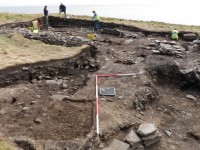 In the last week of excavation the site finally revealed its secrets. Firstly, the main house was founded on natural boulder clay. Thus its date – when ultimately revealed by radiocarbon and archaeomagnetic analyses – will help illuminate when the Viking Age settlement was established.
In the last week of excavation the site finally revealed its secrets. Firstly, the main house was founded on natural boulder clay. Thus its date – when ultimately revealed by radiocarbon and archaeomagnetic analyses – will help illuminate when the Viking Age settlement was established.
Secondly, the features north-east of the house resolved into several phases of entrance passage leading from its gable door. Thirdly, the Viking house had indeed been cut through Pictish (and possibly earlier Iron Age) buildings and middens, still preserved in the south-west corner of the trench. At last these Pictish middens were sampled for study of bones and botanical remains – and a shell deposit was collected for study of climate change using stable isotope analysis. We also collected soil samples to learn more about the middens. What do they contain? Why did so much refuse accumulate in Pictish times, but almost none at all during the later Viking Age?
As time ran out we rushed to complete the final drawings in the shadowy sun of a late Wednesday evening. Thursday morning it was time to start reinstating the site. Tons of earth and stone had to be replaced by hand, the site ‘sculpted’ to show the topography of the underlying house, and the turf replaced. Even with the help of four intrepid local volunteers from Orkney Builders it was very demanding work.
As is typical in archaeology, these last days held a final surprise. Among our pile of excavated stone (which, unlike the excavated soil, was not metal detected to ensure artefacts could not escape recovery) a small zoomorphic mount of copper alloy was found by Polish exchange student Martyna Wiejacka. It must originally have been within the walls or rubble fills of one of the excavated structures.
By 7pm Friday night the crew had to stop, the job almost complete, to pack camp in time for a Saturday morning ferry. I stayed on with my family for the weekend, replacing the last earth and turf on Sunday. There was time for one final site tour, for the passengers of a visiting cruise liner. Our experience as one part of the ‘Deerness in 100 Objects’ initiative was complete.
James Barrett
Week 4 on the Brough
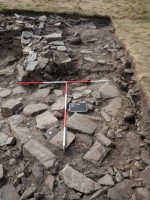 Kerbed pathways or a Pre-Viking buildingNow in the penultimate week of the excavation the tension is rising. Will we complete the excavation of the Viking Age house? What will predate it?
Kerbed pathways or a Pre-Viking buildingNow in the penultimate week of the excavation the tension is rising. Will we complete the excavation of the Viking Age house? What will predate it?
In the north-east corner of the trench we at last completed the excavation of later buildings and discovered the original extent of the Viking Age house. At the same time we uncovered a new cluster of features that must be either an earlier building, cut by the Norse house, or several phases of kerbed paths leading into its northern doorway.
Inside the house we continued excavating yet another floor layer, complete with central hearth. Having sectioned the fireplace we now know that this was the original floor of the house – its first phase! Zoe Outram of the University of Bradford visited to take samples for archaeomagnetic dating. To get an overhead view of the house, on an isolated sea stack where it is unrealistic to set up a scaffolding tower, Frank Bradford kindly loaned us his extending photographic boom for a day.
To the west, our work focused on recording and removing small Viking Age outbuildings in order to sample the large Pictish middens into which they were built. The bones and plant remains from these middens will be able to tell us much about making a living in pre-Viking Orkney. Recovering these biological remains was one of the goals of our excavation, yet the discovery of more and more small buildings in this part of the site has made the timetable very tight. With only a few days left before we must backfill it remains to be seen whether we get there in time.
The crew are putting in longer and longer hours to get the job done. So far moral remains high, helped along by fabulous communal meals in the dig house!
In other ‘Deerness in 100 Objects’ activities, Viking Age living history interpreters set up camp at the entrance to the Mull Head Nature Reserve, in which the site lies, and I gave a lecture (at nearby St Ninian’s Kirk) regarding our excavation progress thus far. The organisers invited everyone back to the ‘100 Objects’ exhibition for tea and biscuits afterwards, which was a good opportunity to both socialise and pick up more local knowledge.
James Barrett
Week 3 on the Brough
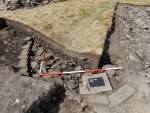 The third week of excavation has passed in an instant! Around the edges of our trenches we’ve found yet another Viking Age building, and walls that may well turn out to be parts of pre-Viking ones. At the centre of our excavation the recording of a now fully uncovered Viking Age house has begun – starting with the central hearth and side aisles marked by edge-set stones. In the earth floor of the house we discovered a glass ‘linen smoother’ (a Viking Age iron), more typically known from female pagan graves. Another exciting find is red deer antler, indicating a local population of animals (now extinct in Orkney) from which Deerness may have acquired its (originally Old Norse) name.
The third week of excavation has passed in an instant! Around the edges of our trenches we’ve found yet another Viking Age building, and walls that may well turn out to be parts of pre-Viking ones. At the centre of our excavation the recording of a now fully uncovered Viking Age house has begun – starting with the central hearth and side aisles marked by edge-set stones. In the earth floor of the house we discovered a glass ‘linen smoother’ (a Viking Age iron), more typically known from female pagan graves. Another exciting find is red deer antler, indicating a local population of animals (now extinct in Orkney) from which Deerness may have acquired its (originally Old Norse) name.
In other aspects of the research, Poul Heide continued to survey the surrounding landscape, including measuring the gap between the mainland and the Brough (18 metres) by rope. 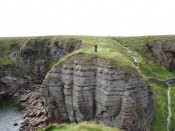
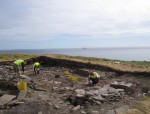 On Friday and Saturday the tall ships visiting Orkney passed by, reminding us of the site’s strategic position looking out over the sea road that leads into the heart of the islands.
On Friday and Saturday the tall ships visiting Orkney passed by, reminding us of the site’s strategic position looking out over the sea road that leads into the heart of the islands.
Although we try to give tours to all visitors at any time, our open day on Sunday saw a particularly steady stream of interested people from Deerness, elsewhere in Orkney and the world (the most distant traveller was from Australia). It was impossible to keep count, but perhaps 100 people made the hike onto the Mull Head Nature Reserve during a foggy morning and sunny afternoon. They came with both questions and local wisdom.
James Barrett
15 July 2011


